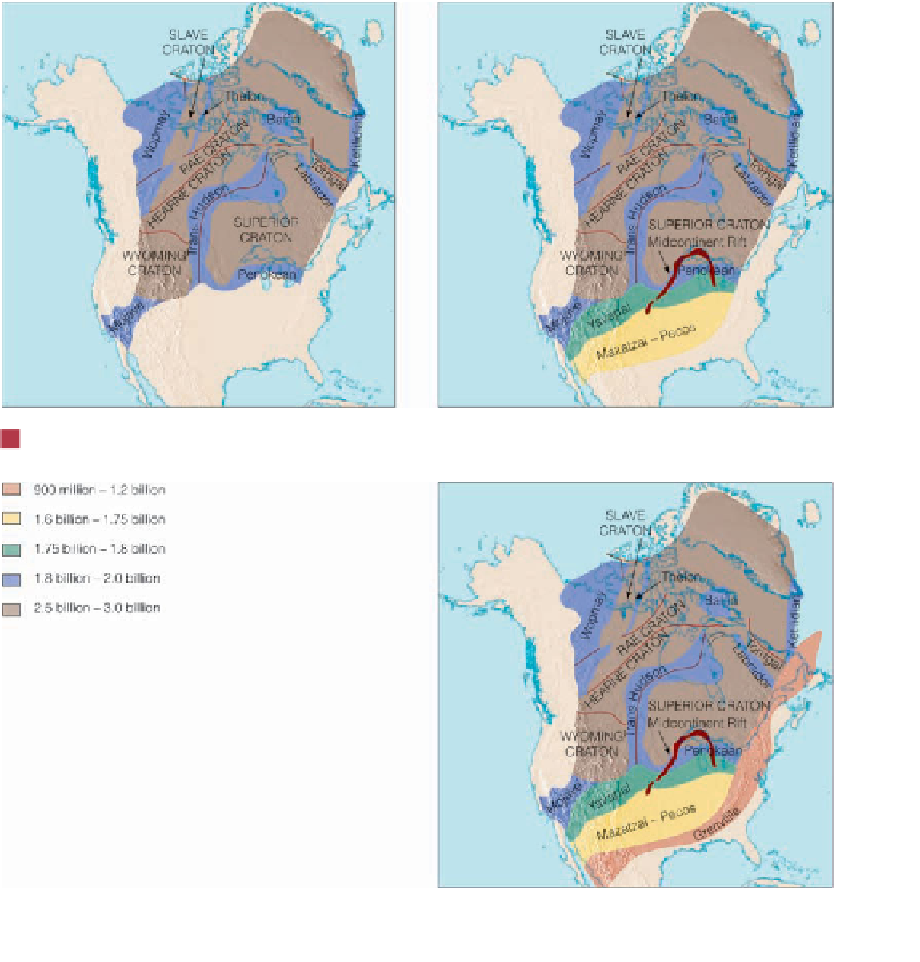Geology Reference
In-Depth Information
◗
Figure 19.9
Proterozoic Evolution of Laurentia
a
During the Early Proterozic, Archean cratons were
sutured along deformation belts called orogens.
b
Laurentla grew along its southern margin by accretion
of the Central Plains, Yavapai, and Mazatzal Orogens.
c
A fi nal episode of the Protoerozoic accretion occurred
during the Grenville orogeny.
Source: Reprinted from K.C. Condie,
Plate Tectonics and Crustal Evolution
, 4
th
edition, p. 65 (Fig. 2.26),
copyright ©1997 Butterworth-Heinemann. Reprinted with permission from Elsevier.
Good examples of these craton-forming processes
are recorded in rocks of the Thelon orogen in north-
western Canada where the Slave and Rae cratons col-
lided, and the Trans-Hudson orogen, in Canada and the
United States, where the Superior, Hearne, and Wyoming
cratons were sutured (Figure 19.9a). Sedimentary rocks of
the Wopmay orogen in northwestern Canada are important
because they record the opening and closing of an
ocean basin, or what is called a
Wilson cycle
. A com-
plete Wilson cycle, named after the Canadian geologist
J. Tuzo Wilson, involves rifting of a continent and the open-
ing of an ocean basin with passive continental margins on
both sides (
continent-continent collision, during which the rocks
that formed along the previous passive continen-
tal margins and seafloor are deformed during an orog-
eny (Figure 19.10f). Some of the rocks in the Wopmay
orogen belong to a suite of sedimentary rocks called
a
sandstone-carbonate-shale assemblage
that is
deposited on passive continental margins. Paleoproterozoic
sandstone-carbonate-shale assemblages are widespread
in the Great Lakes region of the United States and Canada
(
Figure 19.11). The sandstones (now quartzites) have a
variety of sedimentary structures such as ripple marks and
cross-beds, whereas some of the carbonate rocks, now mostly
dolostone, contain abundant stromatolites (Figure 19.11c).
Following the initial episode of amalgamation of Archean
cratons, accretion took place along Laurentia's southern mar-
gin. From 1.8 to 1.6 billion years ago, continental accretion
◗
Figure 19.10). As rifting proceeds, an expan-
sive ocean basin forms, but it eventually begins to close, and
subduction zones and volcanic island arcs develop on one
or both sides of the ocean basin. The fi nal stage involves a
◗



Search WWH ::

Custom Search